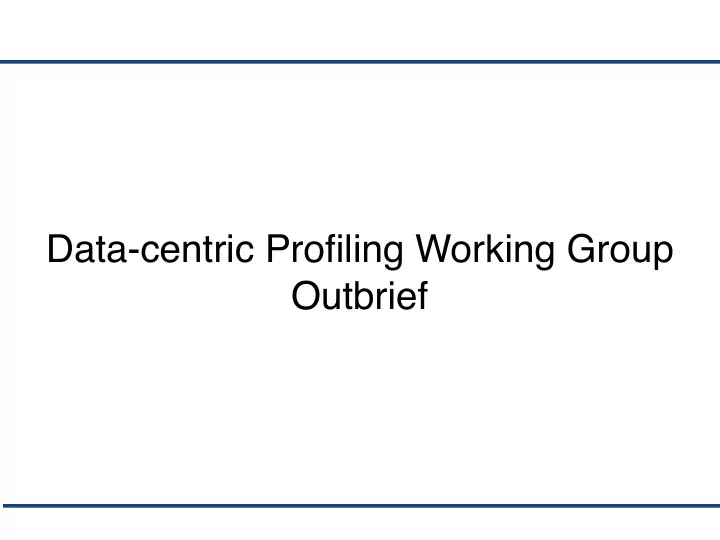

Data-centric Profiling Working Group Outbrief
Basic Concept Associating performance data with data objects (arrays), beyond • code contexts (loops, procedures) – PMU support – data-centric attribution – use of data-centric profiling � 2
Data-centric Profiling WG Current PMU support • – Intel PEBS, AMD IBS, IBM Mark events to sample memory accesses • effective address, latency, memory layers – monitoring loads only is not enough, but also stores/prefetching instructions • use L1D replacement event (https://software.intel.com/en-us/forums/intel-performance- bottleneck-analyzer/topic/326007) – better to monitor evicted cache lines • Jeff’s paper: http://www.cs.umd.edu/~hollings/papers/ijhpca06.pdf – LBR: use call stack mode (monitoring calls/returns) to reconstruct the call stack • 16 frames on average with 32 LBR slots – Intel PT • ptwrite (Goldmont), a lightweight printf triggers LBR. Call ptwrite inside malloc can obtain the call path from LBR – page fault events, a hardware event (Goldmont) • possible measure first touch location – limitation • no PID or TID. OS Kernel needs to get this information • PEBS latency_above_threshold may produce biased results – sample MEM_LOAD/MEM_RETIRED � 3
Handle attribution to data structures • – static — easy to handle from symbol table • need Dyninst to extract allocation source lines from DWARF – heap • high overhead if malloc/free are frequently called – probably use ptwrite to reduce the overhead • call stack is important – merge the objects allocated in the same call path – (David) meaningful allocation site may a few frames above the “malloc” – stack • (Xiaozhu) Dyninst supports to extract the information from DWARF � 4
Use of data-centric profiling • – locality optimization • data layout optimization – David has some work in helping developers change data layout • temporal locality – false sharing • HITM events for loads – may miss store-store false sharing • Intel PTU, toplev, Feather (Xu’s group) identify false sharing – NUMA optimization • lightweight pattern analysis across threads – structure splitting • identify how different fields of a data structure are accessed – structslim from Xu’s group: https://dl.acm.org/citation.cfm? id=2854053 � 5
Challenges Stephane: how to do data profiling offline • – collect all raw data online with low overhead – perform data attribution offline – timestamp information Michael: automate the fix • – Joseph (UPenn)’s approach of detecting and fixing false sharing – Intel PGO can improve a DB workload by 25% to guide global data reorganization on Itanium Stephane: compiler support to annotate each memory access • instruction – which type accessed – the offset Michael: data-centric profiling on small cores • – insights for temporal locality � 6
Recommend
More recommend